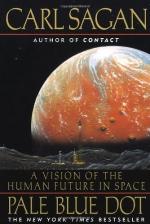
|
| Name: _________________________ | Period: ___________________ |
This test consists of 15 multiple choice questions and 5 short answer questions.
Multiple Choice Questions
1. What visual resolution would be required to determine the existence of intelligent life on Earth?
(a) 1 meter.
(b) 100 meters.
(c) 1,000 meters.
(d) 10 cm.
2. When probes enter the atmospheres of other planets, what color do they often see the sky to be?
(a) Yellow.
(b) Black.
(c) Red.
(d) Blue.
3. In the analogy Sagan makes in Chapter 5 the reader is asked to imagine they are seeing Earth from what perspective?
(a) Very close up.
(b) From a distorted frame of reference.
(c) For the first time.
(d) From an immense distance.
4. What does Sagan say that philosophy and religion should provide?
(a) Guidance.
(b) Truth.
(c) Comfort.
(d) Kindness.
5. What is notable about the Sun's light in Sagan's distant picture of the Earth?
(a) It is extremely dim.
(b) It appears to bathe the Earth in light.
(c) It creates a halo around the Earth.
(d) It appears as many distinct shafts of light.
6. Which of the following is a major point opponents of space exploration raise?
(a) No good has ever come of space exploration.
(b) Space exploration exists for national prestige only.
(c) The problems on Earth should be solved first.
(d) There is nothing of value anywhere else in the solar system.
7. What does the Geocentric theory state?
(a) The Earth moves in a perfect circle.
(b) The sun moves around the Earth.
(c) The Earth is a flat disc.
(d) The planets and heavens are all fixed.
8. What was the state of the knowledge and belief about life on other planets at the time the book was written?
(a) Scientists expected to find life on most of the planets and moons.
(b) It was believed there was abundant life on Mars.
(c) No signs of life were known to exist.
(d) Most believed life on other planets was impossible.
9. What does Sagan suggest that cavemen were usually looking for when they wandered?
(a) Shelter.
(b) Food.
(c) Mates.
(d) New territory.
10. What does Sagan say is an easy way to visually identify planets?
(a) Their movements.
(b) Their brightness.
(c) Their size.
(d) The color of their atmospheres.
11. Where does Sagan think that life will most likely be eventually found?
(a) Deep space.
(b) A moon in the solar system.
(c) Mars.
(d) Earth-like planets around other stars.
12. Sagan helped to discover that Saturn provides what critical element to Titan?
(a) A magnetosphere.
(b) Hydrogen.
(c) Energy.
(d) Tidal forces.
13. What is notable about pictures taken of the Earth from the moon?
(a) There is no visible sign of mankind.
(b) The Earth is always in a half-eclipse.
(c) No landmasses can be seen.
(d) The Earth appears completely dark.
14. Sagan suggests that the image of the "pale blue dot" teaches the need for what?
(a) Peace.
(b) Kindness.
(c) Science education.
(d) Space exploration.
15. What is notable about the stars in Sagan's distant picture of the Earth?
(a) An immense number are visible.
(b) They have many different colors.
(c) They appear very close.
(d) Very few are visible.
Short Answer Questions
1. Titan orbits what planet?
2. How does Sagan describe his reaction to the difficulties in detecting human life and intelligence on Earth from space?
3. What role does Sagan suggest that religion has played in the development of science?
4. The Voyager probes found large amounts of what element on Titan?
5. Sagan believes that Titan hosts oceans made of what compound?
|
This section contains 542 words (approx. 2 pages at 300 words per page) |

|




